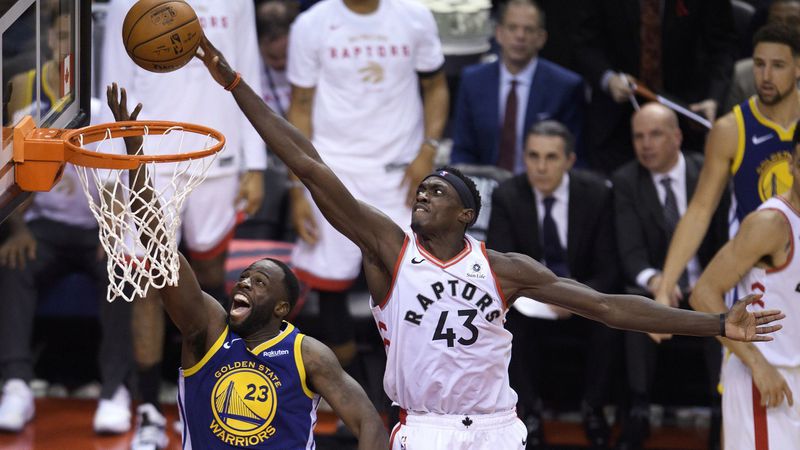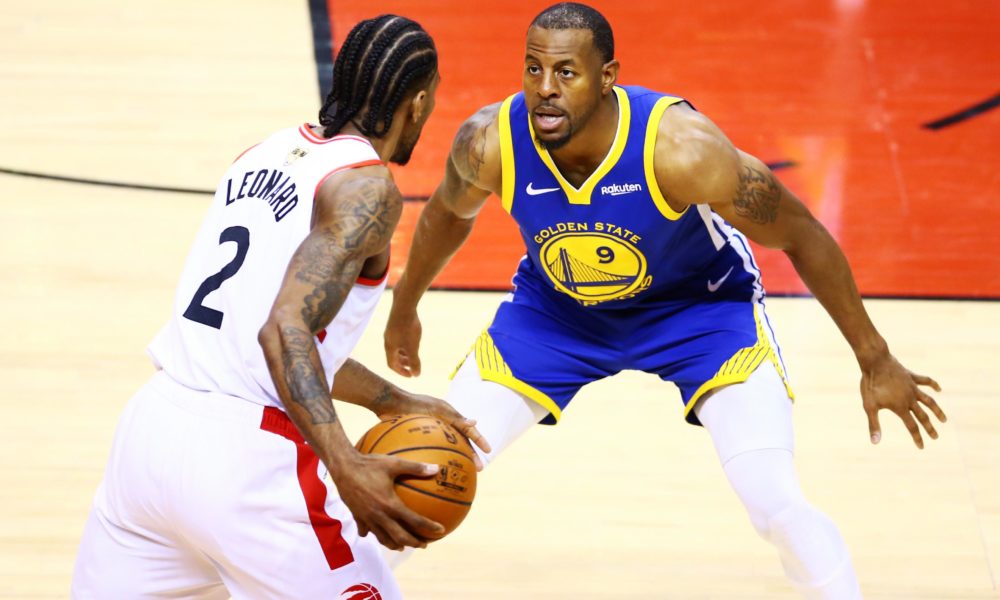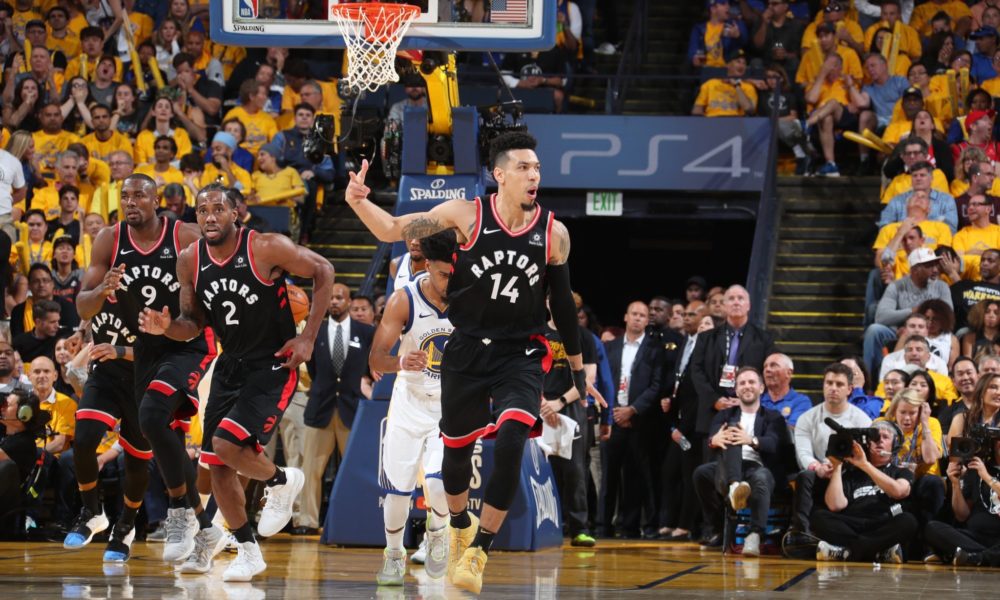There is no shortage of storylines in an NBA final featuring the Warriors playing for a three-peat with Kevin Durant injured, Steph Curry on the greatest playoff run of his life, and Kawhi Leonard making his case for the game’s greatest player. But, as Dan Devine writes, while “the starrier battles lie elsewhere, no single position in this series carries as much potential for chaos as the center spot.” The Toronto Raptors and Golden State Warriors exist in opposite ends of the spectrum when it comes to center deployment, but whichever team is able to seize control of the terms of engagement at the 5 will have a big advantage for the remainder of this series.
Steve Kerr and the Warriors seem to approach the center as a mercenary position, using a rotating cast of hired guns at the 5 throughout the playoffs. In this playoff run alone, the Warriors have started DeMarcus Cousins four times, Jordan Bell once, Damian Jones once, Andrew Bogut six times, and Draymond Green seven times. The Raptors, on the other hand, have had the same starting lineup every game this playoff run, with Marc Gasol starting at center and Serge Ibaka coming off the bench. Head coach Nick Nurse seems to trust Gasol more than Ibaka and values the playmaking and post-scoring Gasol brings to that unit.
Marc Gasol good PnR defense part 3 pic.twitter.com/KzpEpzJEyc
— ISO BALL PODCAST (@isoballpod) May 31, 2019
People around the league expected Toronto’s center deployment to change somewhat drastically against the Warriors. After all, Ibaka is technically better suited to stay on the floor against the Warriors because he is slightly quicker than Gasol and can defend the perimeter better for when the Warriors inevitably get Curry switched onto an opposing big man. But Ibaka has played just 18.2 minutes per game this series, all at the 5, and — save for an excellent shift in the fourth quarter of game 3 where he had five blocks — has been much worse than Gasol, who is averaging 28.9 minutes per game.
People also expected Toronto to unlock their own version of the lineup of death with Pascal Siakam at the center spot. After all, the Warriors are the best team at running opposing big men off the floor — with or without Green at center — and Siakam is the perfect counter being the most versatile two-way frontcourt piece the Raptors have, a 6-foot-9, 230-pound, “defend-every-position-and-run-pick-and-roll” player. Siakam at center lineups were very effective in the regular season, “outscoring opponents by 18.4 points per 100 possessions in just more than 400 total possessions of floor time, according to Cleaning the Glass.” Those lineups have played just two minutes during the playoffs, according to NBA.com.
Up to and including the Kawhi Leonard trade, Masai Ujiri built this Raptors team with the Golden State Warriors in mind. The Raptors being this versatile is no coincidence. Them having the luxury to choose between Ibaka, Gasol, and Siakam at the five — or playing any combination of them including all three together — is good roster construction. You need to be versatile in order to win an NBA championship. Just think about the route the Raptors took to be here, two wins away from a ring: After a fairly straightforward series against the Orlando Magic, they relied heavily on Ibaka in the Philadelphia 76ers series, playing Ibaka and Gasol together for long stretches in order to maximize size and rebounding, and Ibaka came up huge in game 7 with a 17 point, eight rebound performance. Against the Milwaukee Bucks, the Raptors relied on Gasol for his three-point shooting, but Ibaka and Gasol played together a lot once again to combat the Bucks’ reliance on bigs. Now, up against the Warriors, the Raptors are yet to play Ibaka and Gasol together despite being outrebounded for long stretches and playing only seven men (for the most part).
So, why have the Raptors kept their regular center rotation against the Warriors, playing one traditional center at any given time? And how big (or small) will the Raptors get this series? Well, the answer to the first question has a lot to do with Gasol, who has been brilliant defensively, navigating between defending the perimeter and clogging the paint. The answer to the second question, however, is much more complicated and depends on the health status of key Warriors and Nurse’s desire to innovate.
Playing one traditional center
The Raptors have gone with either Gasol or Ibaka at the center spot for every minute against the Warriors, without the two sharing the floor at all. As mentioned earlier, Gasol has gotten the majority of those minutes because, despite being slightly slower, his length and basketball IQ allow him to defend both the paint and perimeter on defense while he moves the ball well offensively. Gasol also dominated DeMarcus Cousins in their match-up in game 3, attacking Cousins whenever possible, taking four shots in the opening six minutes and eventually playing Cousins off the floor.
Gasol great in PnR defense part 2 pic.twitter.com/qVzwGhXJkF
— ISO BALL PODCAST (@isoballpod) May 31, 2019
Ibaka, despite being quicker and a better rim-protector than Gasol, doesn’t have the decision making to play big minutes against the Warriors. In game 3 he committed two dumb fouls on Curry three-point looks, sending the point guard who doesn’t miss to the charity stripe. Ibaka is also often slow deciding whether he should clog the paint or close out on shooters, giving guys like Curry just enough room to get off a good shot.
Nurse can continue playing one traditional center, but it means Gasol, who is already averaging near 30 minutes, is going to have to play a lot of tough minutes defending the Warriors. That is no easy task for a 34-year-old 7-foot-1, 255-pound center in his first NBA finals. He already had a below-average game 2, and if Ibaka can’t provide better minutes and Gasol doesn’t provide enough consistency, Nurse will have to shake things up to get the most out of his players.
Going Big
In the previous two playoff series’, the Raptors played big with Ibaka at the four and Gasol at the five for long stretches. Nurse had little choice because both the 76ers and Bucks were big, physical teams causing problems on the glass, and the Raptors’ secondary options like Green, VanVleet, and Powell weren’t providing enough shooting to justify playing them more than Ibaka.
However, teams rarely go big against the Warriors because of their ability to create mismatches with Curry attacking big men who are too slow to keep up. Playing Gasol and Ibaka together would provide ample opportunity for the Warriors to create that type of mismatch, but it would also allow the Raptors to control the boards while only having one non-shooter on the floor (Ibaka). Considering the Warriors are playing big lineups with Green and Bogut or Green and Cousins, which hurt the Raptors in game 2, the Raptors can afford to go big and still have more shooting than the Warriors. It could work if the Raptors want to slow the game down and dominate the boards as the 2016 Cleveland Cavaliers did, but playing long stretches with both Ibaka and Gasol on the floor limits minutes for guys like Green and VanVleet, who have both emerged as key players in this series.
Siakam at the 5
The lineup Raptors fans have been eagerly anticipating all playoffs is one featuring Pascal Siakam at the center spot. As mentioned earlier, those lineups were very effective in the regular season, but more often than not featured OG Anunoby at the 4, who is technically available to play but likely won’t after so much time off (due to an emergency appendectomy). Nurse might be waiting for Durant to return and the Warriors to trot out their own lineup of death with Green at the 5 before playing Siakam there, or maybe he is just keeping the trick up his sleeve until the right moment presents itself.
This is elite level basketball on both ends. Ball movement and defensive awareness/rotation. pic.twitter.com/x26Evs1rp9
— ISO BALL PODCAST (@isoballpod) May 31, 2019
The reason Kerr hasn’t played Green at the 5 much since KD went down is because the Warriors simply don’t have enough shooting or wing-depth without Durant to make those lineups work for long stretches The Raptors, on the other hand, may eventually go to a lineup with Siakam at the 5 precisely because of their shooting and wing depth.
Not only does Siakam at the 5 provide ideal switchability against a Warriors team that feeds off mismatches and the smallest bit of room to get off a shot, but it also allows the Raptors to play their best players more often. As mentioned earlier, Ibaka is having a bad series, and one way to get Gasol some rest without playing Ibaka is to go to Siakam at the 5. This also allows the Raptors to give more minutes to Green and VanVleet, who have both been exceptional throughout the series but are battling for minutes at the second guard spot. In order for the Raptors to maximize their strengths they need to play VanVleet, who has emerged as their best Curry-stopper, and Green, who is shooting 47.3 percent from deep this series, as much as possible. A lineup featuring Lowry-VanVleet-Green-Leonard-Siakam might be Toronto’s best bet at taking down a healthy Warriors team, but don’t be surprised if we see it as early as game 4.



